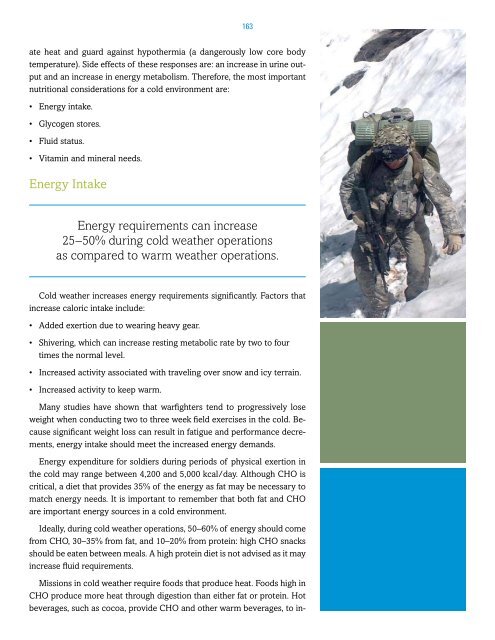special-operations-nutrition-guide
special-operations-nutrition-guide
special-operations-nutrition-guide
Create successful ePaper yourself
Turn your PDF publications into a flip-book with our unique Google optimized e-Paper software.
163<br />
ate heat and guard against hypothermia (a dangerously low core body<br />
temperature). Side effects of these responses are: an increase in urine output<br />
and an increase in energy metabolism. Therefore, the most important<br />
<strong>nutrition</strong>al considerations for a cold environment are:<br />
• Energy intake.<br />
• Glycogen stores.<br />
• Fluid status.<br />
• Vitamin and mineral needs.<br />
Energy Intake<br />
Energy requirements can increase<br />
25–50% during cold weather <strong>operations</strong><br />
as compared to warm weather <strong>operations</strong>.<br />
Cold weather increases energy requirements significantly. Factors that<br />
increase caloric intake include:<br />
• Added exertion due to wearing heavy gear.<br />
• Shivering, which can increase resting metabolic rate by two to four<br />
times the normal level.<br />
• Increased activity associated with traveling over snow and icy terrain.<br />
• Increased activity to keep warm.<br />
Many studies have shown that warfighters tend to progressively lose<br />
weight when conducting two to three week field exercises in the cold. Because<br />
significant weight loss can result in fatigue and performance decrements,<br />
energy intake should meet the increased energy demands.<br />
Energy expenditure for soldiers during periods of physical exertion in<br />
the cold may range between 4,200 and 5,000 kcal/day. Although CHO is<br />
critical, a diet that provides 35% of the energy as fat may be necessary to<br />
match energy needs. It is important to remember that both fat and CHO<br />
are important energy sources in a cold environment.<br />
Ideally, during cold weather <strong>operations</strong>, 50–60% of energy should come<br />
from CHO, 30–35% from fat, and 10–20% from protein: high CHO snacks<br />
should be eaten between meals. A high protein diet is not advised as it may<br />
increase fluid requirements.<br />
Missions in cold weather require foods that produce heat. Foods high in<br />
CHO produce more heat through digestion than either fat or protein. Hot<br />
beverages, such as cocoa, provide CHO and other warm beverages, to in-


